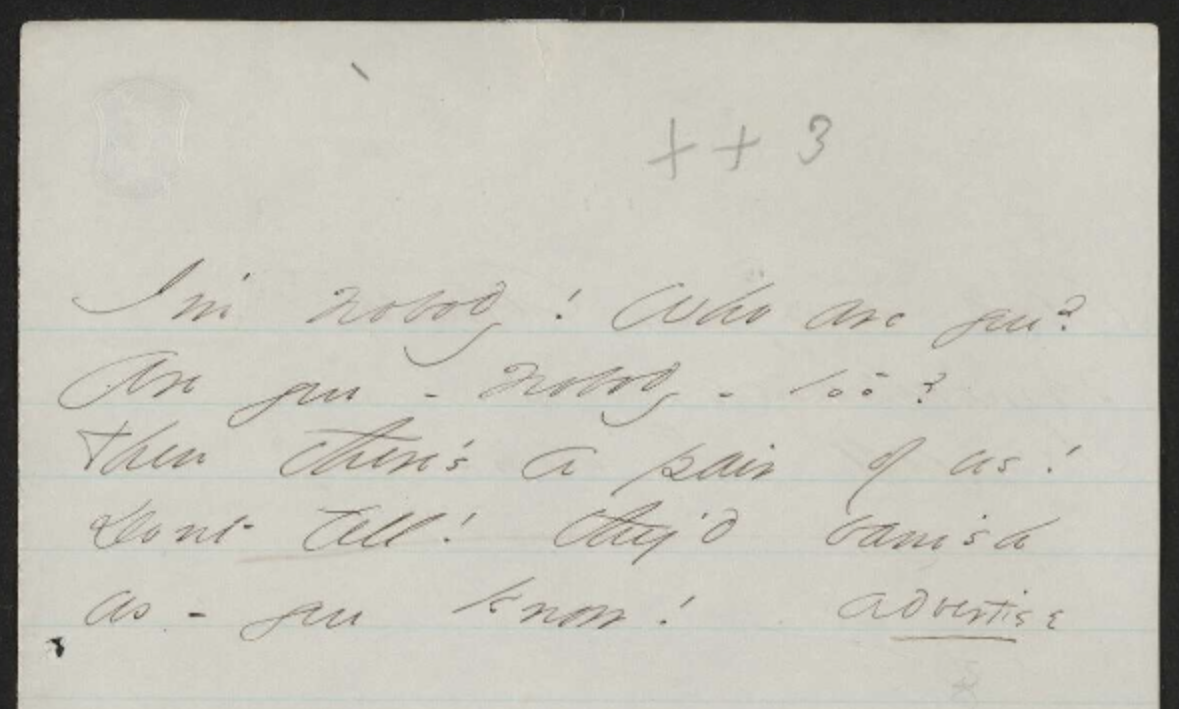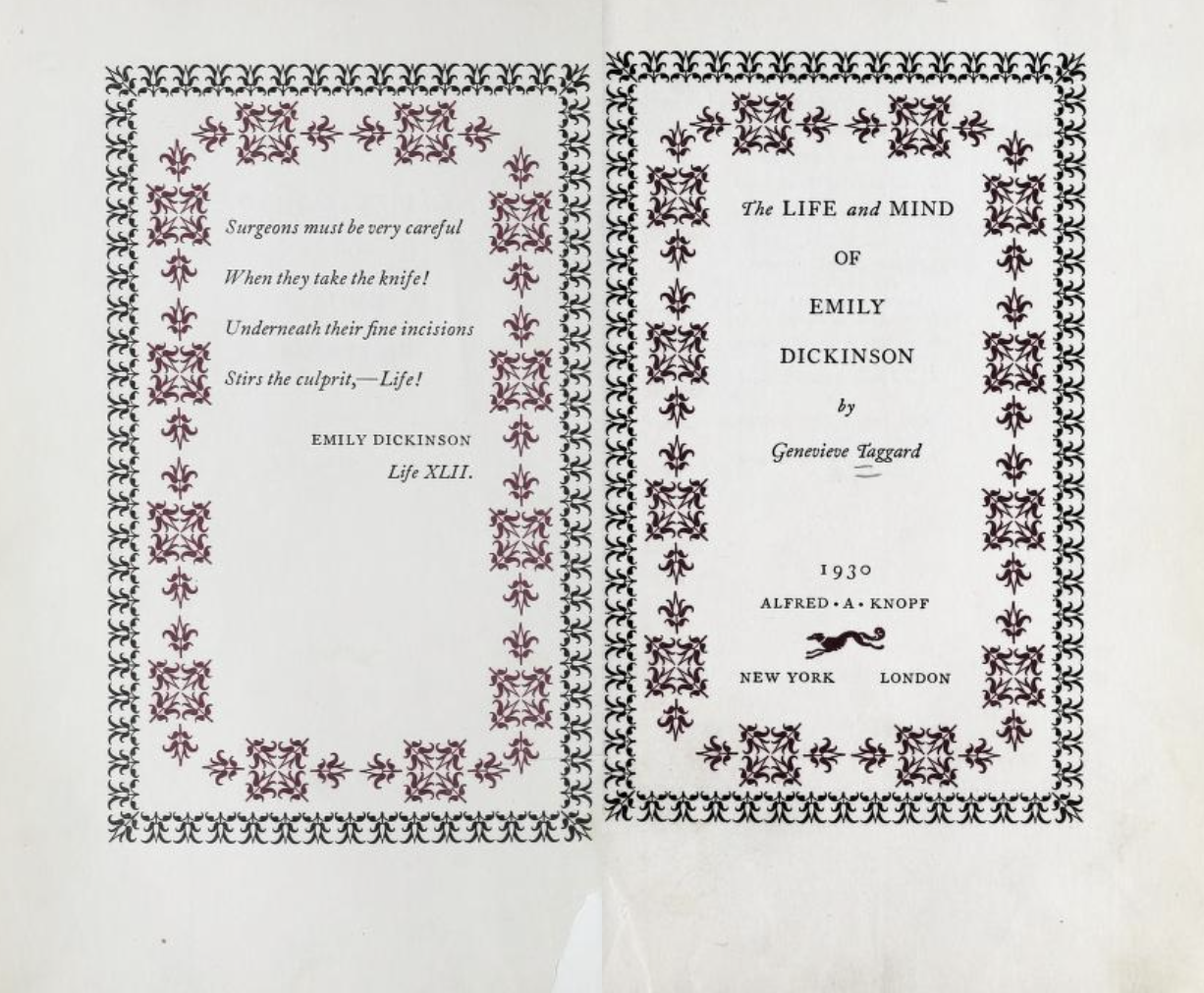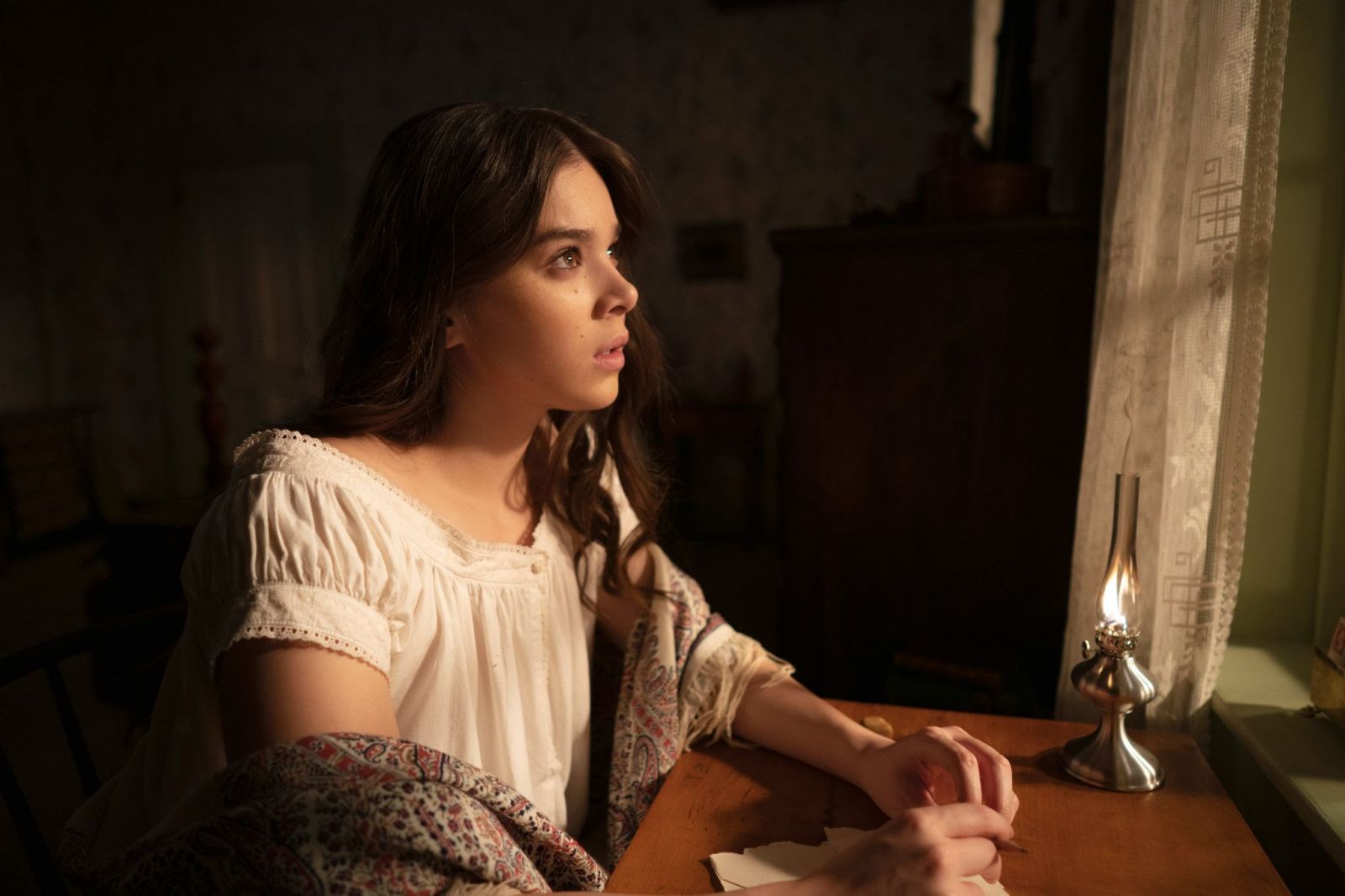- The Ghosts of Emily Dickinson: Hauntings in Popular Culture
- Introduction: Which Dickinson? by Jeannette Schollaert
- Specters on Screen
- Big Reputations: Celebrity and Temporal Duration in/of Dickinson Lyrics by Elizabeth Dinneny
- Ghosts in the Algorithm: The Dickinsons on TikTok by Elizabeth Dinneny
- "Dickinson-core" by Jeannette Schollaert
- Contributors
- Works Cited
Introduction: Which Dickinson? by Jeannette Schollaert

Fig. 1. Image Description: Screen capture of the first stanza of Dickinson’s poem “I’m Nobody! Who are you?” Image features five lines of handwritten script in pencil on off-white paper with light blue lined ruling. The handwriting is long and looped, with many dashes and unusual spacing. Also on the paper, in the top margin, are Susan Dickinson's penciled marks “++3.” Image access courtesy of Harvard University’s Emily Dickinson Archive.
She will elude us all,
Run from any but her own call.
Read her own page, reader.
Wait… read the great verse. Do not look up if you think you hear her.
Do not for a moment stir.
She will come near, confidently nearer,
Even as I write this, she is here.
Genevieve Taggard, “Dedication,” The Life and Mind of Emily Dickinson, 1930
The ghost of Emily Dickinson has possessed the pop culture zeitgeist of the last five years. From movies, to television shows, to music and aesthetics, Dickinson’s haunting lyrics and long, white dress seem to be everywhere. Yet to limit Dickinson’s influence on our spirits to only the past five years is shortsighted, as Dickinson’s ghost has always played a role in American cultural aesthetics. We all know some version of the story – Emily Dickinson, the Myth of Amherst, the recluse, the poetess, the strange, silent figure in the second-floor window of the yellow house on Main Street in Western Massachusetts. The first edition of Dickinson’s poetry, published just a few years after her death, includes a preface by editor Thomas Wentworth Higginson that paints a picture of a reclusive woman surrendering to her imaginative powers, and this image of Dickinson was rigorously marketed to the general reading public. Higginson himself published selections of his correspondence with Dickinson in The Atlantic in order to provide a better picture of the curious woman behind the explosive verse.
We welcome a wide audience to enjoy this exhibition on Dickinson’s ghost in popular culture. In this exhibition, we identify and analyze cultural artifacts haunted by Dickinson from the past five years in order to explore the persistence of Dickinson’s ghostly spirit on screen, in music, and in the culture at large. This Introduction serves as an overview of the publishing history that circulated partial versions of Dickinson’s life and lyrics, versions based on biased readings of the many Emily Dickinsons contained in her archives. We offer this brief historical account of Dickinson’s hauntings from the previous centuries to serve as a general background for any reader whose interest in Dickinson has been piqued by the recent boom in Dickinson-related media. All entries in this exhibition take up the question of Dickinson’s ghost, and the many versions of Dickinson that populate our cultural imaginary.

Fig. 2. Image Description: Screen capture of title page and epigraph of Genevieve Taggard’s 1930 biography, The Life and Mind of Emily Dickinson. The left page features an epigraph, a quote from Dickinson’s poem “Surgeons must be very careful.” The epigraph is in italicized type. On the right, the recto title page, features the title of the biography, the author’s name in italics, and the year and publishing information (1930, Alfred Knopf). Both pages feature fanciful border decoration, the outer border in a black design, and an inner border in a red design that looks like something between an art deco flower and a snowflake.
Dickinson’s ghostly command of popular intrigue is complicated, as each individual, let alone generation, seems to create their own cherished vision of the poet. In his Atlantic article in which he publishes some of Dickinson’s correspondence to him, Higginson seems to delight in the piece of correspondence that Dickinson signed as “Your Gnome.” A few decades later, the Modernist poet Genevieve Taggard chooses to conjure Dickinson’s image as a ghostly predecessor in her poetic Dedication to her biography of Dickinson. In the early twentieth century, the publication of Dickinson related material was its own corner of the literary market – a phenomenon that remains true to the present day, as scholars and authors alike create and publish their own versions of Dickinson. But the early twentieth century posed its own unique conditions for the creation of Dickinson’s ghosts – it was not until 1945 that "a substantial majority of Emily Dickinson’s poems appeared in print," a good fifty-five years after the first volume of her poetry was published (Perlow “Who Gets Emily Dickinson?”). Though some of Dickinson’s poems were published during her lifetime, the first full length edition of her poetry was published after her death. Essentially, Dickinson as a public poetic figure has only ever existed in the American cultural imaginary as a ghost. Dickinson’s verse was initially published in a series edited by Mabel Loomis Todd and Thomast Wentworth Higginson. The first edition debuted in 1890 with subsequent editions in 1891 and 1896. In the twentieth century, Emily’s niece Martha Dickinson Bianchi began publishing Dickinson poems from her family’s collection of manuscripts, courtesy of her mother, Susan Dickinson, the love of Emily’s life. Bianchi’s collection, The Single Hound, was published in 1914, and a memoir-biography, Emily Dickinson Face to Face, followed in 1932. Due to these steady waves of publications, Dickinson’s work never really left the public eye – despite even the fact that Bianchi’s editions were published in the midst of a world war and a Great Depression, respectively. Dickinson’s verse – powerful in its own right – coupled with the idealization of her reclusive life were a powerful imaginative force for literary types experimenting with Modernist techniques in a changing world. Dickinson’s allure was such that her life and verse captivated writers like Genevieve Taggard – an experimental poet, a Greenwich Village bohemian. Taggard’s biography, published just two years before Bianchi’s own recollections of her famous aunt, asks insistent questions about the already-calcifying image of Dickinson as recluse:
We do not remember much but legend of a person when we have only half seen a hurrying whiteness. Where shall we find her, then? Where is she hidden? For there was an Emily Dickinson in the town of Amherst. We can see her own door-posts, and, beside her window, the pine-tree she looked at. (xii)
Forty-four years after Dickinson’s death, Taggard writes her biography making consistent references to the ghost she warns of in her Dedication, which serves as the epigraph for this Introduction. In places in her book, Taggard includes parentheticals like “(and I feel her eyes, large and piercing, like her father’s, upon me as I write)” (xiiii). Taggard, also a poet, perhaps felt a kinship with Dickinson that inspires her insistence on the materiality of Dickinson’s life, as she attends to the woman who lived and died, the pine tree and the house that remain, and the poems that can only capture a fragment of the person herself.
The same year that Taggard’s biography was published, Susan Glaspell debuted her play Alison’s House. Glaspell’s play, which would go on to win the Pulitzer Prize in Drama, uses Dickinson’s life and death as the inspiration for her plot about a recently deceased poet’s family who cleans and empties her home following her death. Set in Iowa as opposed to Amherst, Glaspell made a few tweaks to the Dickinson family history in her play. The connection to Dickinson is clear despite these tweaks, yet Glaspell distanced herself from Dickinson’s life story in her reflections about her play: “The play was in no way founded on the life of Dickinson. It grew out of a feeling for her work and character” (Glaspell 310). Again, Dickinson’s ghost inhabits the play more fully than a strict biography, as Glaspell takes small pieces of the vision Dickinson offers and reimagines an impression of the poet while insisting that the play is entirely separate from Dickinson. In the early twentieth century, Dickinson’s power was especially strong for white women writers seeking to make sense of their own place in the literary world, taking solace in the work of a singular genius whose biography left so much room for experimentation as a plot for other stories. Glaspell’s play seems to continue to ask similar questions as Taggard’s biography – where shall we find this poet, this genius, this shadow?
By the mid-century, Dickinson scholarship had begun to close ranks. Rebecca Patterson’s 1951 book, The Riddle of Emily Dickinson, was the first to propose that the oft-remarked about great romance of Dickinson’s life was with a woman, specifically, Patterson argues, with Kate Anton. Patterson’s work was dismissed and quickly followed up by Harvard University’s attempt to write a definitive narrative of Dickinson in its publication of Thomas Johnson’s three-volume The Poems of Emily Dickinson in 1955. While the early twentieth century allowed for poetic exploration of Dickinson’s life story, the midcentury turn to academic narratives seemed to foreclose the amount of acceptable play one could employ with the story of Emily’s life. Taggard’s interrogative biography is a relic of an earlier, freer, experimentation with Dickinson compared to the academic narratives published in the wake of the academy’s dismissal of Patterson’s work.
Dickinson remained an important touchstone in academic scholarship of American literature through the late twentieth century, especially with Richard Sewall’s 1974 biography, The Life of Emily Dickinson, as well as Harvard’s release of another definitive edition of Dickinson’s poetry in R. W. Franklin’s The Manuscript Books of Emily Dickinson (1981). Martha Nell Smith’s intervention in Dickinson scholarship is especially notable in that, with Rowing in Eden (1992) and Open Me Carefully: Emily Dickinson’s Intimate Letters to Susan Huntington Dickinson (1998), edited with Ellen Louise Hart, readers were invited to more deeply consider Dickinson’s relationship with her friend, lover, and sister-in-law, Susan. The ghosts unlocked from this thread of scholarship have a profound impact on the reimaginings of Dickinson to follow in the subsequent decades, as this scholarship reconsidering Susan’s role in Emily’s life and writing directs us to reconsider the things not said about Sue and Emily in almost a century of previous publications, writing, and scholarship. Here, play is reintroduced to stories of Dickinson’s life, and we can reacquaint ourselves with ghosts forced to hide in the post-war decades.
As Dickinson’s manuscripts entered the digital age and became accessible through online archives such as the original version of this site, the Dickinson Electronic Archives, as well as Harvard and Amherst’s digital collections, any reader with an internet connection could access Dickinson’s writings and assess the shadows of her pencil for themselves. Dickinson scholarship widened, reading Dickinson in terms of her queerness, her material environment, her interest in gardens and flowers, and more. Michelle Kohler notes in her Introduction to the 2019 collection, The New Emily Dickinson Studies:
The transformation of Dickinson from alone and idiosyncratic (for better or worse) to avidly engaged and often exemplary in her critical and poetic acumen has crucially deepened our understanding of Dickinson’s canny attention to her nineteenth-century world. Given the mythical versions of her biography and the feminist politics at stake, it has been important to outline not only Dickinson’s cultural engagement but also her agency, to see this woman poet choosing, even when her choice is, as Sharon Cameron argues, not to choose. (3)
Yet what does it mean now, in 2021, that so many popular culture artifacts and trends are choosing from these various versions of Dickinson choosing? We see Terence Davies’ Dickinson choosing spirituality and caretaking; we see Madeleine Olnek’s Dickinson choosing love with Susan; we see Alena Smith’s Dickinson choosing to turn her back on fame; we see Taylor Swift’s Dickinson choosing her gardens and lovers. The Dickinsons we choose say as much about our current moment in time as they do about the poet herself. These choices to evoke various Dickinsons for various ends are not made in ignorance – each contemporary artist reinventing or repositioning Dickinson is doing so out of respect for and a critical awareness of Dickinson’s unique power in the American cultural imagination. We have the ability – through decades of scholarship and academic debate, through online archives such as this one – to research and understand more about Emily’s life than perhaps ever before, but we also have an overwhelming amount of information to choose from. To follow Taggard, where shall we find Emily amidst all these Dickinsons? Due to the recent explosion in Dickinson-inspired art, media, and aesthetics, it’s worth taking a closer look at each of the new Dickinsons available to us.

Fig. 3 Image Description: Promotional still of Hailee Steinfeld as Emily Dickinson in season 2, episode 3 of the Apple TV+ production, Dickinson. Image features Steinfeld, a young adult white woman, as Dickinson sitting at a writing desk. She wears a white dress and a shawl with her slightly curled brown hair down, and looks up and out a window, away from her writing.
This Exhibition is a curated but by no means comprehensive exploration of how Dickinson’s ghost has been reimagined in recent years on screens big and small, in music, and in the cultural aesthetics of fashion and leisure activities. This consideration of Dickinson’s everlasting influence in American culture asks: how is Dickinson understood in these various retellings of her life story? How do these versions of Dickinson reflect our own experiences coming to know the poet in school and again as adults? Why are we so intensely drawn to Dickinson in the midst of crisis, of pandemic, of racial justice movements, of sheltering in place? How does Dickinson’s imagination live with us among this particular time?



